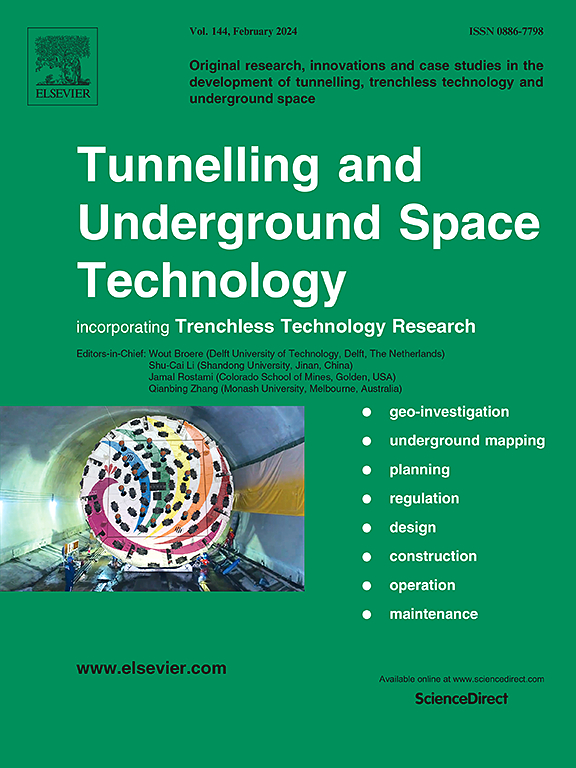Herschel-Bulkley流体在粗壁岩石裂缝中的流动分析
IF 6.7
1区 工程技术
Q1 CONSTRUCTION & BUILDING TECHNOLOGY
引用次数: 0
摘要
水泥浆液是典型的非牛顿流体,其通过裂隙地层的流动行为受浆液流变特性(如屈服应力和粘度)和岩石裂隙几何特性(如表面粗糙度和可变孔径结构)的支配。特别是岩石裂隙复杂的孔隙结构,使得流场复杂且非均质化,极大地增加了岩石注浆工程实践中所必需的压力梯度-流量关系的理论预测难度。在本研究中,我们旨在分析孔径结构对粗壁岩石裂隙中Herschel-Bulkely (H-B)浆液流动特性的影响。本文采用聚丙烯酸钠溶液制备H-B流体,并在3d打印粗壁断裂和光滑平行板模型上进行流动实验。基于正则化herschel - bulkley - papanastasiou (H-B-P)流变模型,对各模型中的浆液流动进行了数值模拟。实验结果与数值结果吻合较好,验证了数值方法的有效性。在不同法向应力作用下,利用小波分析将裂缝表面分解为三层,形成一系列孔径结构,用于数值模拟渗流过程。根据数值计算结果,建立了一个能反映浆液在粗壁模型中流动与平行板模型的偏差的回归拟合函数。通过对另一条粗壁裂缝压力梯度-流量关系的独立预测,验证了修正后的理论模型的正确性。高分辨率的实验和数值结果揭示了H-B流体流动对施加的正应力和粗糙度的响应;修正后的理论模型可用于预测H-B流体在粗壁岩石裂隙中的流动,对工程实践中的岩石注浆分析具有指导意义。本文章由计算机程序翻译,如有差异,请以英文原文为准。
Analysis of Herschel–Bulkley fluids flow through rough-walled rock fractures
Cement grouts are typical non-Newtonian fluids, the flow behavior of which through fractured strata is governed by rheological properties of the grouts (e.g., yield stress and viscosity) and geometrical characteristics of rock fractures (e.g., surface roughness and variable aperture structures). Particularly, the complex void structure of rock fractures renders the flow field complex and heterogeneous, significantly increasing the difficulty of theoretically predicting the pressure gradient – flow rate relation that is essential for rock grouting in engineering practice. In this study, we aim to analyze the effect of aperture structure on flow behavior of Herschel-Bulkely (H–B) grout flow in rough-walled rock fractures. Here, H–B fluids were prepared using Sodium Polyacrylate solutions and flow experiments were conducted on 3D-printed rough-walled fracture and smooth parallel-plate models. Grout flow through these models were numerically simulated based on the regularized Herschel–Bulkely–Papanastasiou (H–B–P) rheological model. Well-matched results were obtained between experimental and numerical results that validated the numerical method. The fracture surface was then decomposed into three levels using a wavelet analysis subject to different normal stresses to create a series of aperture structures for numerical simulations of the flow process. A regressively fitted function based on numerical results was developed that can reflect the deviation of grout flow through a rough-walled model from a parallel-plate model. This modified theoretical model was validated by applying it to predict the pressure gradient-flow rate relation of another rough-walled fracture independently. The high-resolution experimental and numerical results revealed the response of H–B fluid flow to the applied normal stress and roughness; the modified theoretical model can readily be used to predict H–B fluids flow through rough-walled rock fractures, which is useful for rock grouting analysis in engineering practice.
求助全文
通过发布文献求助,成功后即可免费获取论文全文。
去求助
来源期刊

Tunnelling and Underground Space Technology
工程技术-工程:土木
CiteScore
11.90
自引率
18.80%
发文量
454
审稿时长
10.8 months
期刊介绍:
Tunnelling and Underground Space Technology is an international journal which publishes authoritative articles encompassing the development of innovative uses of underground space and the results of high quality research into improved, more cost-effective techniques for the planning, geo-investigation, design, construction, operation and maintenance of underground and earth-sheltered structures. The journal provides an effective vehicle for the improved worldwide exchange of information on developments in underground technology - and the experience gained from its use - and is strongly committed to publishing papers on the interdisciplinary aspects of creating, planning, and regulating underground space.
 求助内容:
求助内容: 应助结果提醒方式:
应助结果提醒方式:


